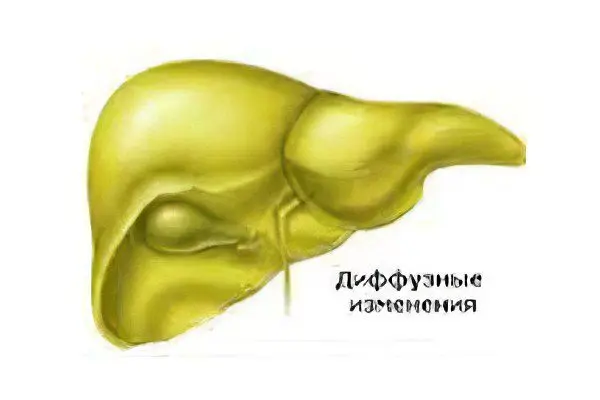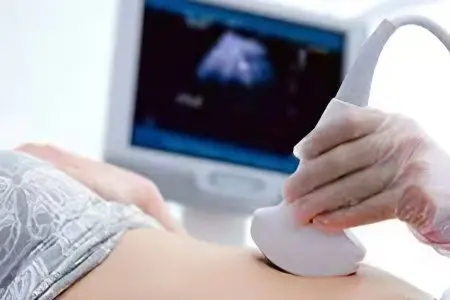Contents

The liver is the organ that does not declare itself for a long time in case of illness. Most often they are detected during an ultrasound scan. And quite often in the extract you can find a small but frightening entry – diffuse changes in the liver parenchyma. Do not panic, first you should try to figure out what this phrase means. As such, the diagnosis of “diffuse changes in the liver parenchyma” does not exist. The record can only mean that certain processes are taking place in the organ that caused such a state. But because of what this happened, it is necessary to determine with the help of studies of a different nature.
Diffuse changes can be a symptom of such diseases:
cirrhosis
any hepatitis
sclerosing cholangitis
autoimmune hepatitis
To understand what we are talking about, you should know that the parenchyma is not a shell, but a collection of the most important elements responsible for the functioning of the organ. The liver consists entirely of parenchymal tissue, which, in turn, is formed from certain cells – hepatocytes.
Therefore, speaking about the fact that the parenchyma has diffuse changes, the doctor means the transformation of the liver tissue. So, minor deviations may be the result of a viral disease. But there are also severe lesions, so it is imperative to conduct additional studies that will reveal the full depth of liver damage. But in any case, diffuse changes in the liver parenchyma cannot be ignored, and identifying the causes that led to such a condition is the key to successful treatment.
Signs of diffuse liver changes
As for the pronounced signs of damage to the liver tissue, they appear quite rarely.
But sometimes the seal can be accompanied by a number of symptoms that a person feels:
After eating, in particular fried or spicy, the appearance of a feeling of heaviness.
Bitter taste in the mouth, most pronounced in the morning after sleep or after eating.
Feeling of weakness and increased fatigue, even after small loads.
Nausea, not justified by poisoning.
Irritability and frequent headaches, sudden mood swings.
The most pronounced signs, especially with the progression of certain diseases that lead to serious changes in the liver parenchyma, are: pain in the right hypochondrium, yellowing of the sclera and even the tongue are alarming symptoms. These are the signs that a person himself can notice and feel, and seek medical help.
Methods of diagnosis

The main method to assess the nature of diffuse changes in the liver parenchyma was and remains an ultrasound study. The signs by which the doctor determines them can be both pronounced and moderate.
To some extent, diagnostics reveals:
All serious diseases, previously transferred or occurring at a given time. They leave noticeable traces on the organ, so the doctor will definitely see these pronounced signs of decomposition of certain areas of the liver.
Moderate signs are usually not so serious, but are noticeable on ultrasound, and can be caused by viruses, malnutrition, etc.
On ultrasound, the doctor determines the size of each lobe of the organ, its echogenicity, as well as the clarity of the contours and the uniformity of the structure.
A competent specialist will immediately see by echo – signs of diffuse changes in the organ, these include:
Fabric of heterogeneous structure.
Parenchyma with increased echo density.
The size of the organ is increased.
The pattern of blood vessels is broken.
In different hepatic lobes, decreased and increased echogenicity is noted.
Sealing of periportal tracts.
Rapid attenuation of ultrasound.
Only a competent specialist with knowledge in the field of physiology and anatomy can diagnose diffuse changes in the structure of the parenchyma of an organ, since this is a complex and time-consuming process. Thanks to modern advances in the field of ultrasound, the possibilities of differential studies have been significantly expanded. But sometimes such a diagnosis alone is not enough, since pathological conditions can be quite serious, and morphological changes are not very pronounced.
The nature of diffuse changes in the parenchyma of the organ and the reasons that caused this condition

Depending on the causes that caused a diffuse change in the liver, it can be of the following character:
Fibrous change in the parenchyma. This happens when, due to certain pathological processes, scar tissue or so-called fibrous tissue begins to grow in the organ. Its appearance can be triggered by a number of diseases, for example: alcoholic, toxic, or viral hepatitis, due to congenital pathology, due to parasitic infection. Fibrotic changes can also be the result of any disease of another organ that has a direct effect on the liver.
Hypertrophic character of parenchyma changes.
Sclerotic changes in the parenchyma.
Swelling.
That is, due to a number of reasons, changes in the parenchyma of the organ occurred, and additional analyzes are necessary to clarify them. The stronger the inflammation, the more noticeable the edema of the parenchyma will be.
Quite often, a similar verdict can be heard in diseases of the following nature:
Diabetes, alcoholism and obesity. The liver in such situations begins to degenerate, increase in size, during the study, the echogenicity of its structure is several times higher than it should be in the norm.
In chronic hepatitis, the liver can be significantly enlarged in size, but diffuse changes are not very pronounced.
If a person has cirrhosis of the liver, then the structure of the organ is completely subjected to diffuse changes, it becomes heterogeneous, there are many damaged areas, echogenicity is greatly increased.
If a cyst or tumor has grown in the organ, then significant changes will be visible in a certain lobe of the liver.
With a viral infection, the liver parenchyma changes, but these processes are not global in nature and the organ recovers on its own after a certain time.
Parasites can also cause diffuse changes in the liver parenchyma.
An irrational approach to nutrition, the use of fatty foods rich in calories, as well as the abuse of alcohol, negatively affects the structure of the organ and causes significant changes in its parenchyma.
As it becomes clear, there can be many reasons that caused radical changes in the structure of the organ. In order to clarify the diagnosis, additional examinations should be carried out. They include taking blood for analysis: general, biochemical and clinical, serological studies, and it is also possible to take a liver puncture, MRI, angiography, radioisotope scanning.
Treatment of diffuse changes in the liver parenchyma

Given that there is no change in the liver parenchyma as such a diagnosis, then treatment methods will be aimed at eliminating the disease that caused such a transformation. After the cause is identified, the hepatologist will determine the therapeutic regimen and prescribe the appropriate drugs.
As a rule, standard methods of treatment include taking medicines according to a certain scheme:
If the changes were caused by viruses, then antiviral agents will be prescribed to reduce their toxic effect on the organ. Etiotropic treatment for hepatitis is reduced to the appointment of certain drugs, depending on its type. And it is also necessary to eliminate additional damaging factors, such as alcohol and other toxins. Hepatoprotectors are often prescribed that can “protect” hepatocytes. These can be drugs, both natural and synthetic, this also includes amino acids, vitamins and phospholipids.
Phospholipids are able to normalize the structure of the liver cell membrane, reduce hepatocyte necrosis, as a result of which biochemical parameters are significantly improved.
Means of natural origin have a stimulating effect on liver cells, due to which hepatocytes are restored, this effect is also achieved due to the choleretic effects of drugs. The digestion process improves, the influence of harmful substances entering the body with alcohol, drugs and food is largely minimized.
The action of synthetic drugs is varied and extremely complex; as a rule, they are prescribed for oncological diseases.
Amino acids allow you to normalize the functioning of the liver and make up for the deficiency of the compounds it needs.
Vitamins of group B and E are hepaprotective and are often prescribed in the general treatment regimen for the liver.
In addition to following the treatment regimen, almost any liver disease that caused its diffuse changes requires following a certain diet. Nutrition will need to be adjusted in a special way, how to do this correctly the doctor will tell you, but the main recommendations are as follows: the exclusion of salt, seasonings, spicy, fatty, fried foods. The introduction of fiber and foods rich in potassium in the diet. Naturally, from the nature of the disease, recommendations will vary in favor of certain products. But alcohol in the treatment of the liver is strictly contraindicated, since in some cases it can not only reduce the effectiveness of the prescribed regimen, but also, in combination with certain drugs, lead to death.
If changes in the parenchyma of the organ are caused only by malnutrition and alcohol consumption, then doctors recommend dietary table No. 5 according to the Pevsner classification, where fortified and protein foods predominate, as well as fermented milk products. Depending on the state of the body, with diffuse changes in the liver parenchyma, immunomodulators and some liver preparations are also prescribed.
Forecast

Naturally, the prognosis for the success of a particular treatment regimen directly depends on the disease that led to diffuse disorders of the liver parenchyma.
If we consider the uncomplicated form of lipomatosis, most chronic hepatitis, as well as changes in the parenchyma due to malnutrition and lifestyle, then competent treatment in most cases leads to the fact that the organ begins to function in the same volume, and its disturbed structure is restored. It should be borne in mind that with lipomatosis, a favorable outcome of treatment will directly depend on which area of the liver was prone to fatty degeneration. Since in this case, the restoration of the affected areas is impossible. It will only be possible to normalize the functioning of unaffected parts of the organ.
An unfavorable prognosis is distinguished by diseases such as cirrhosis, fulminant forms of hepatitis, as well as uncontrolled fatty hepatosis. In these cases, the liver parenchyma changes dramatically, and the organ itself becomes unable to perform its functions. Death most often occurs due to intra-abdominal bleeding or the development of severe infectious diseases.
It should be understood that changes in the liver parenchyma of a diffuse nature cannot be unfounded. Such a violation of the structure of the body is necessarily preceded by a number of reasons. Depending on those factors or diseases that provoked diffuse transformations in the liver parenchyma, appropriate treatment is prescribed by hepatologists. But in order for the moment not to be missed, it is necessary to undergo an ultrasound scan by qualified specialists at least once a year. The sooner diffuse changes in the liver parenchyma are detected, the more favorable the prognosis for complete recovery.









